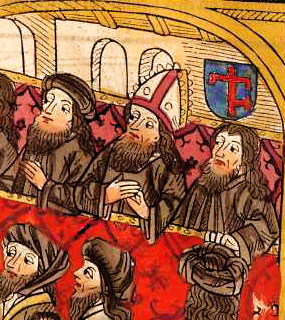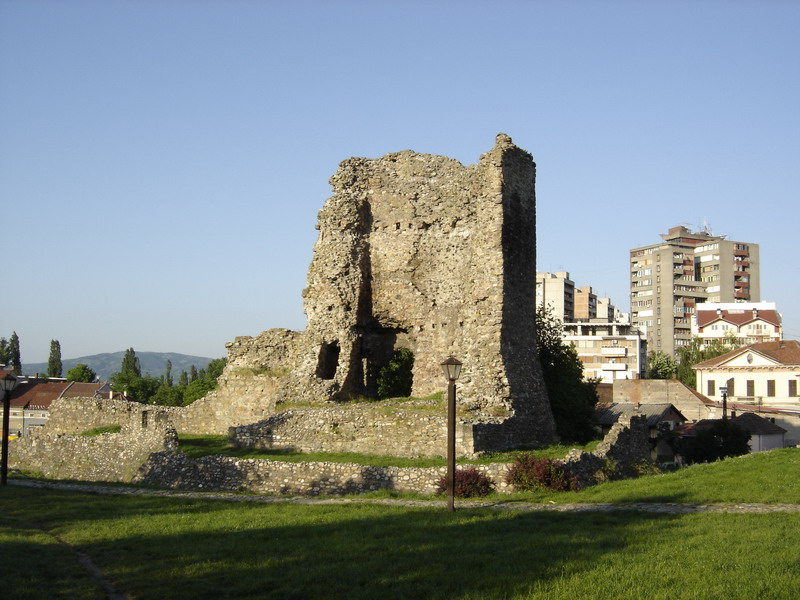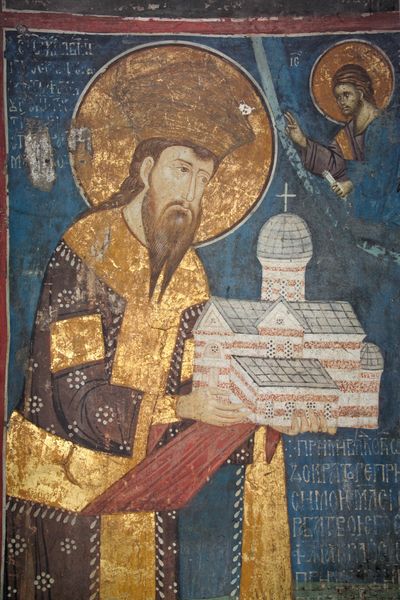|
Resava School
Resava School ( sr, Ресавска школа/Resavska škola), was founded in 1407 by Serbian despot Stefan Lazarević. Based on his endowment, the Manasija monastery, it was called ''Bašta znanja'' or the bastion of knowledge for learning, transcribing, translating and illuminating manuscripts in the Serbian Despotate. One of the main supporters of the Resava school was Constantine the Philosopher (Константин Филозоф), also known as Constantine of Kostenets. The canon of this school was followed in monasteries of Hilandar, Patriarchate of Peć, Visoki Dečani and Ljubostinja, and its influences were present in Russia, Bulgaria, Macedonia, and Romania. Monastery of Manasija, also called Resava, had a library of more than 20,000 books. See also * Gabriel the Hilandarian * Gregory Tsamblak * Isaija the Monk Isaija the Monk ( sr, Инок Исаија or in English: Inok Isaija; ca. 1300–after 1375), also known as Elder Isaija (Elder Isaiah) () and Isai ... [...More Info...] [...Related Items...] OR: [Wikipedia] [Google] [Baidu] |
Serbian Orthodox
The Serbian Orthodox Church ( sr-Cyrl, Српска православна црква, Srpska pravoslavna crkva) is one of the autocephalous (ecclesiastically independent) Eastern Orthodox Christian churches. The majority of the population in Serbia, Montenegro and the Republika Srpska entity of Bosnia and Herzegovina are members of the Serbian Orthodox Church. It is organized into metropolitanates and eparchies, located primarily in Serbia, Bosnia and Herzegovina, Montenegro, and Croatia. Other congregations are located in the Serb diaspora. The Serbian Patriarch serves as first among equals in his church. The current patriarch is Porfirije, enthroned on 19 February 2021. The Church achieved autocephalous status in 1219, under the leadership of Saint Sava, becoming the independent Archbishopric of Žiča. Its status was elevated to that of a patriarchate in 1346, and was known afterwards as the Serbian Patriarchate of Peć. This patriarchate was abolished by the Ottoman Em ... [...More Info...] [...Related Items...] OR: [Wikipedia] [Google] [Baidu] |
Russia
Russia (, , ), or the Russian Federation, is a List of transcontinental countries, transcontinental country spanning Eastern Europe and North Asia, Northern Asia. It is the List of countries and dependencies by area, largest country in the world, with its internationally recognised territory covering , and encompassing one-eighth of Earth's inhabitable landmass. Russia extends across Time in Russia, eleven time zones and shares Borders of Russia, land boundaries with fourteen countries, more than List of countries and territories by land borders, any other country but China. It is the List of countries and dependencies by population, world's ninth-most populous country and List of European countries by population, Europe's most populous country, with a population of 146 million people. The country's capital and List of cities and towns in Russia by population, largest city is Moscow, the List of European cities by population within city limits, largest city entirely within E ... [...More Info...] [...Related Items...] OR: [Wikipedia] [Google] [Baidu] |
Isaija The Monk
Isaija the Monk ( sr, Инок Исаија or in English: Inok Isaija; ca. 1300–after 1375), also known as Elder Isaija (Elder Isaiah) () and Isaija of Serres (Elder Isaiah of Serres) (), was a 14th-century Serbian monk, one of many Serbian monk-scribes in the Middle Ages who translated ancient Greek manuscripts into the Serbian recension of Old Church Slavonic. His major work is the translation of the works of Pseudo-Dionysius the Areopagite from Byzantine Greek. Isaija's commentaries on political events occur in the context of the fall of the Serbian principality of Serres in 1371, which led the descendants of these local governors to accept Ottoman suzerainty. As a young boy, Isaija joined the monastic life of the Serbian Orthodox Church affiliated to St. Joachim of Osogovo Monastery on Osogovo Mountain in northern Macedonia, and then to Hilandar Monastery on Mount Athos in Greece, where he spent the rest of his life. In Hilandar, he worked as a translator and became very ... [...More Info...] [...Related Items...] OR: [Wikipedia] [Google] [Baidu] |
Gregory Tsamblak
Gregory Tsamblak or Grigorij Camblak ( bg, Григорий Цамблак, sr-Cyr, Григорије Цамблак; c. 1365–1420) was a Bulgarian writer and cleric. He was the pretended Metropolitan of Lithuania between 1413 and 1420. A Bulgarian noble, Tsamblak lived and worked in Bulgaria, but also in Medieval Serbia and Kievan Rus'. His literary works represent a heritage of the national literature of Serbia, particularly the style of Old Serbian ''Vita'' made popular in the monasteries of the 12th century. Life He was born in Tarnovo, the capital of the Second Bulgarian Empire, the son of a rich family. His cousin was Cyprian, Metropolitan of Kiev. Tsamblak was a disciple of the prominent Bulgarian hesychast writer Patriarch Evtimiy of Bulgaria. Bulgaria fell under Ottoman domination following the Bulgarian-Ottoman Wars. Following this, he emigrated first to Constantinople, then became presbyter of the Church of Wallachia and Moldavia. He then went to Serbia where he wa ... [...More Info...] [...Related Items...] OR: [Wikipedia] [Google] [Baidu] |
Gabriel The Hilandarian
Gabriel the Hilandarian ( 1359–d. after 1412) was a Serbian monk- scribe. There is very little information available about Gabriel the Hilandarian, like most modest monks who lived in the 14th and early 15th century. It is known that he translated Olympiodorus the Younger's commentary on the Book of Job from Greek in 1411–12. The manuscript is now held at the State Historical Museum in Moscow. In his younger days, Gabriel resided and worked at the Resava (Manasija) Monastery, built between 1407 and 1418 by Despot Stefan Lazarević. According to Constantine of Kostenets, Resava was built specifically as a centre for the followers of the Hesychasm movement, showing that Stefan held them in great esteem. Stefan endowed Resava generously with icons and books, and established a scriptorium and a translation school within the monastery. Old texts were corrected and copied and many were translated from Hebrew, Greek, Old Armenian, Old Georgian, Coptic, Syriac, and Old Latin. Among ... [...More Info...] [...Related Items...] OR: [Wikipedia] [Google] [Baidu] |
Romania
Romania ( ; ro, România ) is a country located at the crossroads of Central Europe, Central, Eastern Europe, Eastern, and Southeast Europe, Southeastern Europe. It borders Bulgaria to the south, Ukraine to the north, Hungary to the west, Serbia to the southwest, Moldova to the east, and the Black Sea to the southeast. It has a predominantly Temperate climate, temperate-continental climate, and an area of , with a population of around 19 million. Romania is the List of European countries by area, twelfth-largest country in Europe and the List of European Union member states by population, sixth-most populous member state of the European Union. Its capital and largest city is Bucharest, followed by Iași, Cluj-Napoca, Timișoara, Constanța, Craiova, Brașov, and Galați. The Danube, Europe's second-longest river, rises in Germany's Black Forest and flows in a southeasterly direction for , before emptying into Romania's Danube Delta. The Carpathian Mountains, which cross Roma ... [...More Info...] [...Related Items...] OR: [Wikipedia] [Google] [Baidu] |
Macedonia (region)
Macedonia () is a geographical and historical region of the Balkan Peninsula in Southeast Europe. Its boundaries have changed considerably over time; however, it came to be defined as the modern geographical region by the mid 19th century. Today the region is considered to include parts of six Balkan countries: larger parts in Greece, North Macedonia North Macedonia, ; sq, Maqedonia e Veriut, (Macedonia before February 2019), officially the Republic of North Macedonia,, is a country in Southeast Europe. It gained independence in 1991 as one of the successor states of Socialist Feder ..., and Bulgaria, and smaller parts in Albania, Serbia, and Kosovo. It covers approximately and has a population of 4.76 million. Its oldest known settlements date back approximately to 7,000 BC. From the middle of the 4th century BC, the Kingdom of Macedon became the dominant power on the Balkan Peninsula; since then Macedonia has had a diverse history. Etymology Both proper nouns ... [...More Info...] [...Related Items...] OR: [Wikipedia] [Google] [Baidu] |
Bulgaria
Bulgaria (; bg, България, Bǎlgariya), officially the Republic of Bulgaria,, ) is a country in Southeast Europe. It is situated on the eastern flank of the Balkans, and is bordered by Romania to the north, Serbia and North Macedonia to the west, Greece and Turkey to the south, and the Black Sea to the east. Bulgaria covers a territory of , and is the sixteenth-largest country in Europe. Sofia is the nation's capital and largest city; other major cities are Plovdiv, Varna and Burgas. One of the earliest societies in the lands of modern-day Bulgaria was the Neolithic Karanovo culture, which dates back to 6,500 BC. In the 6th to 3rd century BC the region was a battleground for ancient Thracians, Persians, Celts and Macedonians; stability came when the Roman Empire conquered the region in AD 45. After the Roman state splintered, tribal invasions in the region resumed. Around the 6th century, these territories were settled by the early Slavs. The Bulgars, led by Asp ... [...More Info...] [...Related Items...] OR: [Wikipedia] [Google] [Baidu] |
Ljubostinja
The Ljubostinja Monastery ( sr, / , ) is a Serbian Orthodox monastery near Trstenik, Serbia. Located in the small mountain valley of the Ljubostinja river, the monastery is dedicated to the Holy Virgin. History The monastery was built from 1388 to 1405. In Ljubostinja were buried Princess Milica, Lazar Hrebeljanović's wife and Nun Jefimija, which after the Battle of Kosovo became a nun along with a number of other widows of Serbian noblemen, who lost their lives in the battles on the river Maritsa and Kosovo Polje. Today, Ljubostinja is a female monastery, which preserves and maintains about fifty nuns. During the rebellion of Kočine, the people were invited on rebellion from the Ljubostinje monastery. After the collapse of rebellion, Turks burned the monastery to revenge the Serbs, and most of the frescoes were destroyed. Also, when the monastery was set on fire, a secret treasure was discovered hidden in the monastery wall behind icons in which the Princess Milica hid t ... [...More Info...] [...Related Items...] OR: [Wikipedia] [Google] [Baidu] |
Stefan Lazarević
Stefan Lazarević ( sr-Cyrl, Стефан Лазаревић, 1377 – 19 July 1427), also known as Stefan the Tall ( sr, Стефан Високи / ''Stefan Visoki''), was the ruler of Serbia as prince (1389–1402) and despot (1402–1427), diplomat, legislator, ktetor, patron of the arts, poet and one of the founding members of the Order of the Dragon. The son of Prince Lazar Hrebeljanović, he was regarded as one of the finest knights and military leaders at that time. After the death of his father at Kosovo (1389), he became ruler of Moravian Serbia and ruled with his mother Milica (a Nemanjić), until he reached adulthood in 1393. Stefan led troops in several battles as an Ottoman vassal, until asserting independence after receiving the title of ''despot'' from the Byzantines in 1402. Becoming a Hungarian ally in 1403–04, he received large possessions, including the important Belgrade and Golubac Fortress. He also held the superior rank in the chivalric Order of t ... [...More Info...] [...Related Items...] OR: [Wikipedia] [Google] [Baidu] |
Visoki Dečani
The Visoki Dečani Monastery ( sr, Манастир Високи Дечани, Manastir Visoki Dečani, sq, Manastiri i Deçanit) is a medieval Serbian Orthodox Christian monastery located near Deçan, Kosovo. It was founded in the first half of the 14th century by Stefan Dečanski, King of Serbia. The Visoki Dečani monastery is located by the Deçan's Lumbardh river gorge at the foot of the Accursed Mountains, in the region of Metohija. It is located about from the town of Deçan. The monastery is managed by the Serbian Orthodox Eparchy of Raška and Prizren. The monastery has been under the legal protection of Serbia since 1947 with a designation of ''Cultural Monument of Exceptional Importance''. The monastery is part of the World Heritage site named " Medieval Monuments in Kosovo". History Construction began during the reign of Serbian King Stefan Dečanski in 1327 and the original founding charter from 1330 has been preserved. Dečanski's son, Stefan Dušan, seized the ... [...More Info...] [...Related Items...] OR: [Wikipedia] [Google] [Baidu] |





